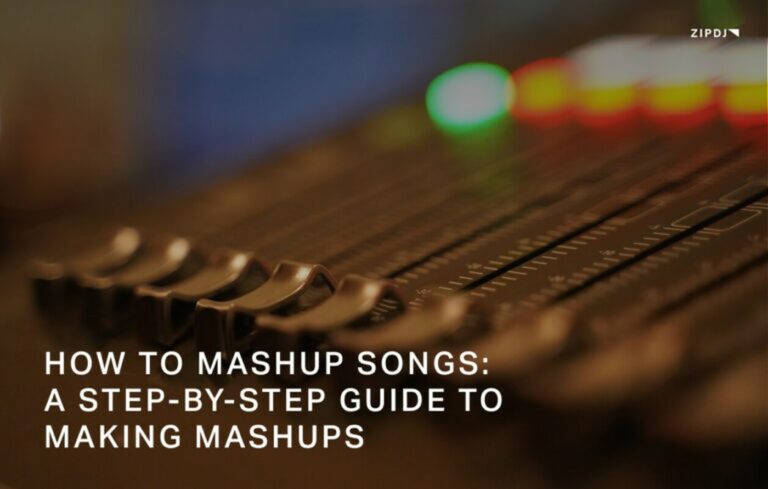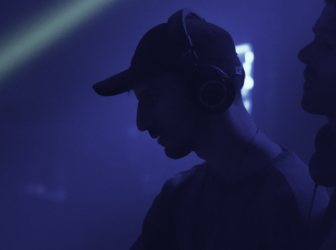How To Make Mashups: A Step-By-Step Guide

Creating a mashup is a tried and trusted method used by the best DJs to create new songs to use in their mixes and set themselves apart from the competition.
A DJ’s secret weapon, the mashup takes vocals and instrumental elements from different tracks, which can be edited together in DJ software or digital audio workstations such as Ableton Live.
Read on to discover how to make mashups of your own, transforming one song into something fun, fresh, and exciting for your next DJ set.

What Is A Mashup?
A mashup is a method music producers, and DJs use to take elements from one song, mix them with another, and create an entirely new track.
Typically, mashups take the instrumental version of one song and blend it with the vocal track of another, merging these elements through music production or DJ software.
They’re a great way to put your unique stamp on a DJ set, create new tracks that won’t be played elsewhere, and learn the basic techniques required for making songs.
What You’ll Need To Make Mashups
Making a mashup requires several tools and elements, ranging from the right digital tools for editing tracks to the songs you want to use.
A professional digital audio workstation is ideal, although you can use free tools to get similar results and save money.
You’ll also need the instrumental and vocal versions of each song in the best possible audio file quality to create your mashup.
Finally, beat matching and key matching tools can be very useful to access unless your software includes these features as standard.
How To Make Mashups (Step-By-Step)
Creating mashups requires several considerations, from choosing the best mashup software to selecting the song elements to use.
We’ve broken down each step to help you choose the best vocals and instrumental tracks to mashup for your new song.
Without further ado, here’s our guide on how to make a mashup of songs:
Step 1: Choose The Correct Editing Software
Before getting started, you’ll need to get your hands on the best mashup software you can to cut up and edit your audio files, whether this is a dedicated music production suite or DJ software.
While some of the best DJ software includes tools for editing mashup songs, you can use plenty of alternatives if you’re on a budget.
Free software such as Audacity and Reaper offers a quick and easy way to get started, with intuitive user interfaces, albeit lacking the more advanced features found in music production software.
Suppose you already use a dedicated digital audio workstation such as Ableton Live, Reason, or FL Studio. These tools will give you much more scope for producing unique compositions from your favorite tracks.
Step 2: Pick Your Music Genres
Once you’ve installed a digital audio workstation on your computer or invested in DJ software, it’s time to decide the genre of music you want to create your mashup for.
This means choosing a music style with a compatible vocal track and instrumental version that works well together and will deliver a great new sound when combined.
Whether you’re mashing up the most popular music genres or mixing underground dance music, determining your genre helps to keep the mashup elements in alignment.
You don’t have to stick exclusively to one genre, and some of the best DJ sets of all time work with multiple genres to great effect, but if you’re new to mashups, it’s best to stick to one or two music styles.
Step 3: Select The Tracks To Mash Up
With a genre selected, the next step to mashup songs is choosing the tracks you want to use to create your new track.
There are plenty of resources where DJs get their music that you can draw on to discover and archive music to use for your mashups.
In addition to online music stores and streaming services, you can sign up for a record pool, which gives you the instrumental and vocal tracks required to mashup your songs.
Step 4: Find The Acapella & Instrumental Version
The original track of your choice can be used for certain aspects of your mashup, but creating an excellent final mashup requires the instrumental version and a vocal track such as an acapella.
Track these versions of each track down from your DJ record pool or elsewhere, then load them into your DJ software or DAW such as Ableton Live.
You can edit the drum beat from the original track, then use this to keep the instrumental track and vocals in time with one another.
Step 5: Match The BPM Of The Tracks
Now that you’ve found two songs to mix up, load the audio files into Ableton Live or your DJ software and make sure the tempo/BPM of the two tracks match.
Your digital audio workstation or DJ software should include a feature that automatically matches the beat and tempo of the tracks, so make the most of this to save time.
If you don’t know how to beat match in your DJ sets, creating mashup songs is an excellent opportunity to hone this handy and versatile skill.
Matching the beats will ensure that all elements are in time with one another, preventing any clashing or discordant beats and vocals.

Step 6: Match The Keys Of The Tracks
Developing a grasp of the musical key is one of the fundamental tips to improve your DJ skills and is especially relevant when making mashup songs.
Both the instrumental version and vocal track used for your mashup will be in an established key, which needs to match; otherwise, your new song will sound off.
Again, take advantage of your music production or DJ software tools to bring the vocal track and instrumental version into one track that matches in key.
You can also use guides such as a Camelot Wheel to see which different keys will match and help you choose two harmonically compatible tracks.
Step 7: Trim & Line Up The Tracks
With the BPM and key ready to go, it’s time to line up the instrumental track with the acapella and beats so that everything is in sync.
You can use the drum beat from the original song as a guide to match the instrumental track and the vocals, zooming in on the waveform of the audio files to nudge them into sync.
Once these match in sync, it’s time to start putting some music production finishing touches to the track and give the new song a unique sound.
Step 8: Balance The Track’s EQ
With everything all lined up correctly, the next step involves using the EQ controls on your DJ software or DAW to ensure all the frequencies are nicely balanced.
If you’ve had experience producing music, you’ll use similar techniques here to adjust the EQ on vocals and instrumental elements so they sit at the correct volume.
Play around with the EQ settings and listen carefully until all elements of the mashup are correctly mixed and sit together seamlessly in your new song.
Step 9: Add Effects To The Track
With all elements of the songs balanced in the EQ, you can now add some effects to add depth, texture, and atmosphere to the mashup.
If you’re using a studio-grade acapella, the vocal track will likely be raw, so consider adding a reverb effect to give these a more spacious feel.
Additional effects that can bring a new dimension to the new song include filters and delays, and if you have your own samples, these can be mixed into the mashup for a personal touch.
If you’ve learned how to scratch DJ and want to bring an additional personal touch while avoiding overused samples, consider sampling your turntable skills and including these in the mashup.
Step 10: Play To An Audience
Playing your new mashup to an audience is the best way to see if it works on the dance floor, gauging their reaction as you introduce it into the mix.
Save the project in the appropriate audio file format so you can play it along with other songs on your DJ mixer and check how it sounds on a big system.
Including your mashups of favorite tracks sets you apart from the competition and can help you to book more DJ gigs and bring something fresh to the dance floor.
FAQs About Mashups
Still unsure what mashups are and how you can create them to include in your upcoming DJ sets?
Read this handy FAQ, and we’ll clarify some key issues around mashups.
1. Are Remixes & Mashups The Same?
While similar elements and processes are involved in producing remixes and mashups, the two have several fundamental differences.
Mashups superimpose the vocal track from one song over the instrumental version of another track to deliver a hybrid version of the two tracks.
Remixes are more in-depth in production terms and involve rearranging a piece of music and making many changes to all elements of the song.
Remixes will often slow down or speed up the song and play with the dynamics in more elaborate ways, as well as adding and subtracting new musical elements.
2. What Software Is Best For Making Mashups?
There is a broad range of software that can be used for making mashups, including free tools such as Audacity and Ashampoo Music Studio to high-end music production suites,
The more professional the tools you use, the more scope you’ll have for polishing your mashup with EQing and the introduction of cool effects to deliver authentic results.
3. Are Song Mashups Legal?
The legality of mashups is a contentious topic for discussion and depends on how easily identifiable elements and samples from the original track are in the end result.
While many artists use mashups in their sets, there is a risk that your work may be taken offline if copyright detection tools pick up a clear sample.
The more you adjust the track in the editing suite and introduce your own production elements, the less likely you’ll run afoul of copyright issues when performing them in your live sets.
4. What App Can I Use To Mashup Songs?
If you don’t have access to a computer or want to be able to put together song mashups on the go, there are several apps you can use to do so.
SongMixer, Pioneer’s WeDJ, and YouTube DJ allow users to easily perform the basic steps necessary to create their own mashups.
Summary
We hope you’ve found this guide exploring how to mashup songs useful, and whether you’re using Ableton Live or free DJ software, you’ll be able to create fantastic song mashups.
Once you master the basics, have fun with the genres and tracks you use for your mashups and explore various vocal and instrumental elements to take them to the next level.
Try them at your upcoming gigs to gauge the audience’s reaction, so you can further refine your mashups to have maximum impact on the dance floor.
Download all the tracks you need and their vocal and instrumental versions from ZIPDJ’s comprehensive DJ pool today.
Not a member ?
Join Today for Unlimited Music Downloads. Visit zipdj.com for more information.



